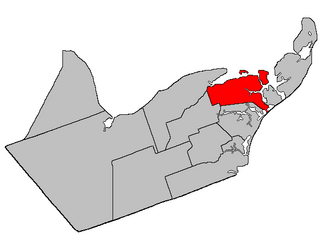
Dundas is a geographic parish in Kent County, New Brunswick, Canada.

Inkerman is a geographic parish in Gloucester County, New Brunswick, Canada.

Dalhousie is a geographic parish in Restigouche County, New Brunswick, Canada.

Bathurst is a geographic parish in Gloucester County, New Brunswick, Canada.

New Bandon is a geographic parish in Gloucester County, New Brunswick, Canada.

Paquetville is a geographic parish in Gloucester County, New Brunswick, Canada.

Caraquet is a geographic parish in Gloucester County, New Brunswick, Canada.

Shippegan is a geographic parish in Gloucester County, New Brunswick, Canada. Located in the northeastern corner of the province at the end of the Acadian Peninsula, the parish consists of the three main islands of Taylor, Lamèque, and Miscou, along with several smaller islands and tidal wetlands; Taylor Island is now joined to the mainland by an isthmus, which is crossed by a causeway.

Allardville is a geographic parish in Gloucester County, New Brunswick, Canada,

Woodstock is a geographic parish in Carleton County, New Brunswick, Canada, surrounding the town of the same name on its landward side.

Saint Andrews Parish is a geographic parish in Charlotte County, New Brunswick, Canada, located east of St. Stephen.

Alma is a geographic parish on the Bay of Fundy in the southwestern corner of Albert County, New Brunswick, Canada.

Pennfield is a geographic parish in Charlotte County, New Brunswick, Canada, located west of Saint John located east of St. George and west of Saint John.

Saint George is a geographic parish in Charlotte County, New Brunswick, Canada, located between St. Stephen and Saint John.

Dumbarton is a geographic parish in Charlotte County, New Brunswick, Canada, located inland north of St. George and south of Harvey.

Saint Patrick is a geographic parish in Charlotte County, New Brunswick, Canada, located west of St. George and Saint Andrews.

Saint Croix is a geographic parish in Charlotte County, New Brunswick, Canada, straddling Route 1 to the north of the original town of Saint Andrews.

Dufferin is a geographic parish in Charlotte County, New Brunswick, Canada, located east of St. Stephen.

Saint Stephen is a geographic parish in Charlotte County, New Brunswick, Canada, located in the southwestern corner of the province.

Saint James is a geographic parish in Charlotte County, New Brunswick, Canada, located north of St. Stephen.




















